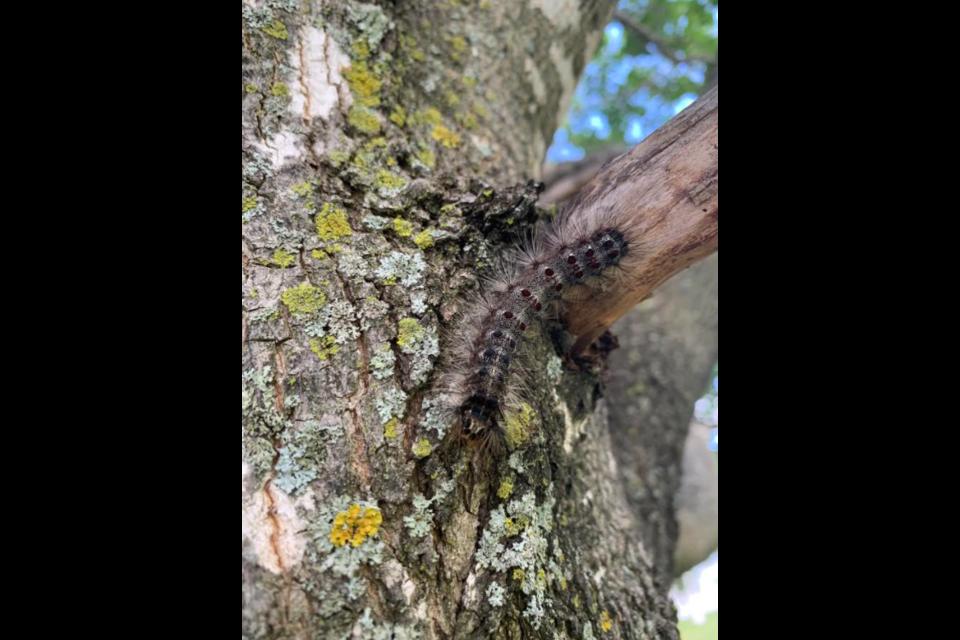Will Barrie’s caterpillar/moth infestation take flight again this year, or will time wind down on the presence of this invasive species?
The short answer is there is no answer in April.
Bugs are not an exact science, says David Dutkiewicz, entomology technician with the Invasive Species Centre in Sault Ste. Marie.
“I wish I had a crystal ball so I can predict down to the last insect in order to tell you what to expect,” he said of Barrie. “It’s a little challenging to predict that, especially dealing with biological critters. They don’t always necessarily do what you want them to do, especially when they’re in larger numbers.”
Last summer, trees in parts of Barrie lost most of their leaves to the caterpillars and the sidewalks were littered with the bugs. Some described it as a nightmare, but other areas of the city were largely unaffected.
Now called the spongy moth, this is the former gypsy moth and until recently the Lymantria dispar dispar (LDD).
Dutkiewicz says the surest sign of infestation is the most obvious one.
“The one part Barrie residents should look for is whether they have an abundance of the egg masses or not,” he told BarrieToday. “You can really find them in cracks of trees, usually under tree branches. I like to think of them as a tennis-ball material like sponge, and they are like a tan colour. They’re usually about the size of a loonie, maybe a bit longer but more of an oblong shape.”
Native to Europe, the spongy moth is established in northeastern United States and eastern Canada — portions of Ontario, Quebec, New Brunswick, Prince Edward Island, and Nova Scotia. The larvae, or caterpillars, feed on the crown foliage of a wide range of hardwood and some softwood trees, which makes it a defoliating forest pest of concern.
They can not only strip trees bare of their leaves but leave a nasty rash on people’s skin, as their hairs are an irritant.
The moth was brought to North America in the 1860s and spread through Ontario about 100 years later.
And Dutkiewicz says the pattern of infestation is also unpredictable.
“The data that’s shown in Ontario is that there is not really a cycle,” he said. “You might find that in New York, where it’s been around for 150 years, so it might have developed a cycle.”
Dutkiewicz says people can nevertheless do their part to keep the pests at bay — scraping off eggs, using tape and burlap on trees to impede their progress.
“I’ve heard of people taking shop vacs and vacuuming them up, the spongy moth egg masses. You just put them in soap and water afterwards and they’ll die after a couple of days,” he said.
But they are coming.
“The caterpillars should actually be starting to emerge very shortly, if they haven’t already,” Dutkiewicz said. “But there are different types of natural predators which do affect these caterpillars.”
He says if it’s a cool, wet spring, there’s a fungus that can significantly damage the caterpillar population, as can NPV.
“It’s a virus that affects the populations when they’re high, so we actually have been seeing a lot of reports of the virus,” Dutkiewicz said.
Barrie operations director Dave Friary said the city’s information is that temperatures below minus-20 degrees Celsius kill exposed egg masses, and that there were 12 nights last January when the mercury dipped below minus-20 C.
“That’s all good news,” he said. “The prediction is we’ll see less this year, anyway.”
There’s also $53,000 in the 2022 budget to aerial spray just more than 86 acres of city woodlots for caterpillar/moths.
But Friary says there’s only one company that sprays in Ontario, ZimmerAir Services from Blenheim, which is already booked solid this year.
So the city is going to Plan B.
Starting in May, summer students will do public education while they’re scraping egg masses in the larger city parks — Centennial and Sunnidale — and wrapping trees to keep the caterpillars off.
“Folks who are walking by or are down in the area can stop by, ask some questions, get some information and the hope is to have them (the students) do this on Saturdays or Sundays, when there’s going to be a lot of people down there,” Friary said.
The second part of Plan B is what he calls “ground control.”
A biological pesticide called TreeAzin, also used to control the emerald ash borer beetle, will be injected in select trees.
“We’ll only be doing public trees and some of the larger ones that we really want to save,” Friary said. “We would determine their health obviously before (injecting TreeAzin).”
Between the students and the biological pesticide, he expects the $53,000 to be spent this year.
And maybe aerial spraying wasn’t the way to go anyway.
“What we’ve heard is the aerial spraying is extremely safe, but there’s still going to be a portion of the population that really doesn’t want somebody flying over their house and spraying even a biological pesticide,” Friary said.
In March 2022, Entomological Societies of Canada and America adopted the name spongy moth as the new common name for the moth species Lymantria dispar. The French common name of the European gypsy moth is Spongieuse, according to the Invasive Species Centre.
For more information, visit invasivespeciescentre.ca.



